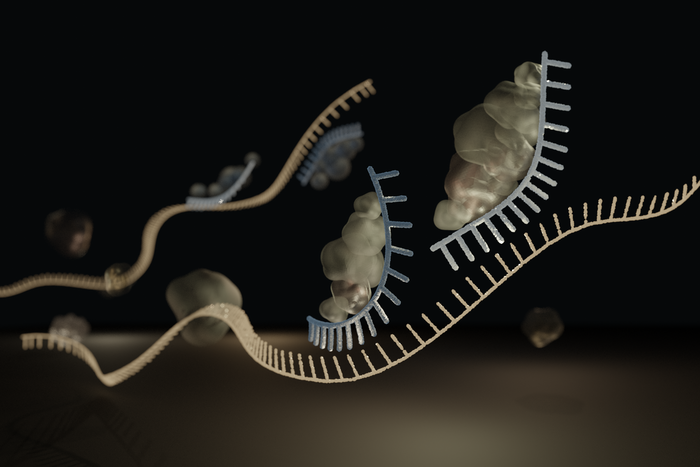Researchers from Nagoya University’s Graduate School of Medicine in Japan have uncovered how microRNA (miRNA) affects inflammation in mice with lupus. They discovered two downregulated miRNAs in the disease along with a rare circumstance where several miRNAs control the same set of genes.
 Researchers identified two miRNAs that are downregulated in the disease and an uncommon situation that occurs in which multiple miRNAs regulate the same set of genes. Image Credit: Reiko Matsushita
Researchers identified two miRNAs that are downregulated in the disease and an uncommon situation that occurs in which multiple miRNAs regulate the same set of genes. Image Credit: Reiko Matsushita
Although there are many other types of RNA in the human body, messenger RNA, which is involved in the production of proteins in the body, is the most significant variety. The body also has miRNA, which binds to messenger RNA to prevent the production of proteins and control various vital biological processes like growth, metabolism, and development.
MiRNA issues have been linked to a wide range of diseases, including HIV and cancer. A study team from Nagoya University has now determined the function of miRNA in systemic lupus erythematosus, a condition in which the body’s immune system assaults itself. Their research was published in BMC Biology.
The “seed” of a miRNA, a sequence that controls whether the miRNA can attach or not, pairs with the right messenger RNA target. The seed functions as a “key” or “lock” for the messenger RNA.
This is exacerbated by the fact that many miRNAs can control a single messenger RNA particle and that a miRNA–messenger RNA pair does not necessarily need to match exactly to have an impact.
Stronger effects are frequently controlled by many miRNAs cooperating since a single miRNA’s effects on a binding receptor site are generally moderate. There are two steps involved in this. Neighborhood miRNA co-targeting is the first of these mechanisms, in which two neighboring miRNAs influence messenger RNA.
The second form of co-targeting, called “seed overlap,” is similar to the neighborhood type except that it involves miRNAs that bind to messenger RNA in a way that causes some of their nucleotides to overlap.
Researchers have long suspected a link since lupus has been associated with altered miRNA expression.
Researchers from Nagoya University Graduate School of Medicine, led by Professor Hiroshi Suzuki at the Department of Molecular Oncology, Lecturer Noritoshi Kato, and Researcher Hiroki Kitai at the Department of Nephrology, have now used mice with lupus to perform miRNA expression profiling to examine the role of miRNA in the disease.
Two microRNAs, miR-128 and miR-148a, were discovered by the researchers to be down-regulated in plasmacytoid dendritic cells in lupus patients.
Due to their critical function in the manufacture of antibodies and antiviral defense, plasmacytoid dendritic cells have been linked to the onset and progression of several autoimmune and inflammatory diseases, including lupus.
Both miR-128 and miR-148a target the KLF4 gene, which plays a role in controlling inflammation and producing cytokines that govern immune system function.
Assuming that the expression levels of the other miRNA are maintained, the downregulation of one miRNA can be compensated for by the other microRNA. However, when two miRNAs decrease simultaneously, as in lupus disease, alterations in their target—in this case KLF4—emerge.”
Hiroshi Suzuki, Professor, Department of Molecular Oncology, Graduate School of Medicine, Nagoya University
One of the study’s most significant results was that miR-128 and miR-148a can attach to messenger RNA using “seed overlap” miRNA co-targeting because they share similar nucleotides.
Suzuki added, “miR-128 and miR-148a target KLF4 through extensive ‘seed overlap’ miRNA cotargeting. In this case, it negatively regulates the production of inflammatory cytokines. Therefore, this study collectively suggests the complexity of different modes of miRNA cotargeting and the importance of their perturbations in human diseases.”
Integrative studies were also carried out by the researchers, who found that “seed overlap” miRNA co-targeting of KLF4 is a common trait in various species.
Suzuki further stated, “Integrative studies were also carried out by the researchers, who found that "seed overlap" miRNA cotargeting of KLF4 is a common trait in various species. Therefore, we expanded these findings by integratively analyzing seed overlap patterns of all miRNAs and the conservation patterns of ‘seed overlap’ target sites.”
Two broad groups of miRNA target sites that exhibit conservation were identified by Suzuki and his study team. Eutherian mammals, which include animals with a placenta, shared the first. The second had a stronger association with both “seed overlap” and “neighborhood” miRNA cotargeting and was shared by other species, including humans and Coelacanths.
“Our study provides a comprehensive view of ‘seed overlap’ miRNA cotargeting, which is very important for the process by which lupus develops from the viewpoint of gene regulation and miRNA evolution. These findings highlight the importance of miRNA co-targeting in human pathology and the unique evolutionary aspects of miRNA co-targeting and miRNA target site conservation,” further added Suzuki.
Suzuki is interested in using his study to help lupus patients.
He concluded, “Testing for downregulation of the two miRNAs may help identify patients with high level of inflammation who may benefit from specific therapeutic development.”
Source:
Journal reference:
Kitai, H., et al. (2023). Systematic characterization of seed overlap microRNA cotargeting associated with lupus pathogenesis. BMC Biology. doi.org/10.1186/s12915-022-01447-4